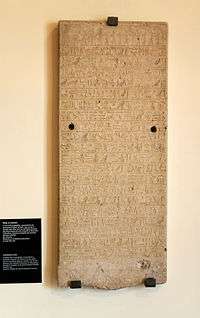Sematawytefnakht
Sematawytefnakht[1] or Somtutefnakht[2][3] and other variants (floruit 330s BCE), was an ancient Egyptian high official, known for having witnessed the conquest of Persian Egypt by the hands of Alexander the Great.
| Sematawytefnakht in hieroglyphs | ||||||||
|---|---|---|---|---|---|---|---|---|
|
sm3 t3w.j tfnx.t Sematawy-tefnakht | ||||||||
 | ||||||||
Biography
Sematawytefnakht probably began his successful career under Nectanebo II of the 30th Dynasty. After the Achaemenid conquest of Egypt in 343 BCE by the hands of Artaxerxes III, Sematawytefnakht swore allegiance to the new foreign pharaoh of Egypt, thus becoming a sort of collaborationist.[1] He is known by his limestone funerary stela – commonly referred as the Naples Stela – which was originally placed in a temple at Herakleopolis Magna, then brought to the temple of Isis at Pompeii and now exhibited at Naples National Archaeological Museum (inv. 1035). From his stela, it is known that Sematawytefnakht entered in Persian service under Darius III and later took part in the Battle of Issus (333 BCE) against Alexander's army.[2][4] Frightened by Alexander's seemingly unstoppable advance and previously advised in a dream by Heryshaf, local deity of his hometown, he fled from the battlefield and returned to Herakleopolis Magna in order to resume his religious offices, thus switching his allegiance once more when, shortly after, Alexander conquered Egypt (332 BCE).[1][2] At the end of his life, Sematawytefnakht praised and thanked Heryshaf for advicing him in the dream, thus allowing him to live a fulfilled life.[2]
During his life, Sematawytefnakht held several high-status charges such as High Priest of Sekhmet, Priest of Horus, Royal treasurer, Sole companion, haty-a and iry-pat.[2]
Other people with the same name
Sematawytefnakht should not be confused with the namesake officer who, some three centuries earlier during the 26th Dynasty, escorted Psamtik I's daughter Nitocris I to Thebes for her adoption as Divine Adoratrice of Amun.
See also
- Udjahorresnet, another ancient Egyptian official and collaborationist who had a comparable career during the early Persian 27th Dynasty.
References
- Wilkinson, Toby (2011). The Rise and Fall of Ancient Egypt. New York: Random House. p. 560. ISBN 9780747599494., pp. 467-9
- Rice, Michael (1999). Who's Who in Ancient Egypt. London and New York: Routledge. ISBN 0-203-75152-3., p. 197
- Lloyd, Alan B. (1994). "Egypt, 404-332 B.C". In Lewis, D.M. (ed.). The Cambridge Ancient History (2nd ed.), vol. VI. Cambridge University Press. pp. 337–60. ISBN 0 521 23348 8., pp. 343-4
- Bresciani, Edda, "EGYPT i. Persians in Egypt in the Achaemenid period," Encyclopædia Iranica, VIII/3, pp. 247-249, available online at http://www.iranicaonline.org/articles/egypt-i (accessed on 26 may 2018).
Further reading
- Tresson, Paul (1931). "La Stèle de Naples". Bulletin de l'Institut Français d'Archéologie Orientale. 30: 369–91.
- Lichtheim, Miriam (1980). Ancient Egyptian Literature, vol. III. Los Angeles: The University of California Press., pp. 42–3
- Pirelli, Rosanna (1998). "Il monumento di Samtawy Tefnakhte e il tempio di Iside a Pompei", in Atti del Convegno di Roma-Pompei 1995 dal titolo "L'Egitto in Italia dall'Antichità al Medioevo". CNR, Roma, pp. 635–644
- Perdu, Olivier (1985). Le monument de Samtoutefnakht à Naples [première partie]. Revue d'égyptologie 36, 89-113.